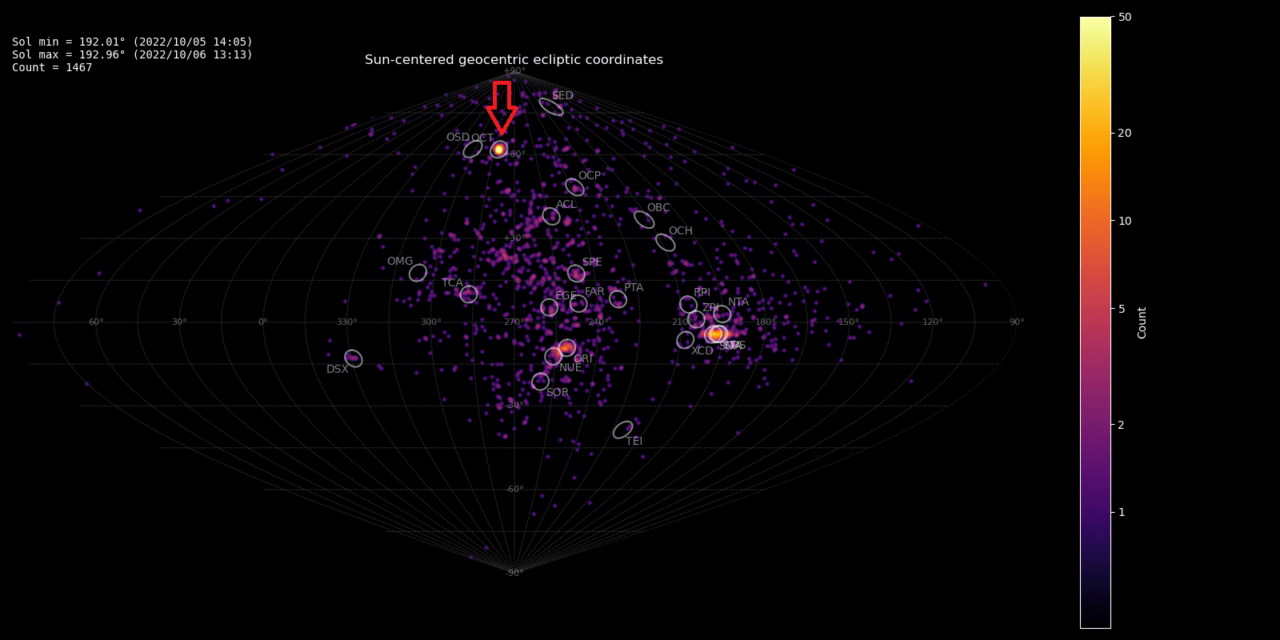By Paul Roggemans, Damir Šegon and Denis Vida
Abstract: In 2022, the Global Meteor Network identified 159 meteors as possible October Camelopardalids (OCT#281), 139 of these within a short time interval of 192.3° < λʘ < 192.75°. The time of maximum activity occurred at λʘ = 192.55° corresponding to 2022 October 06, 03h15m UT. The activity level at maximum with a ZHR of 5 should catch attention of experienced visual meteor observers watching under good circumstances. The radiant has a small diameter of only few degrees and the orbital element diagrams show a very compact concentration of orbits. With a Tisserand value relative to Jupiter, TJ of about 0.5 and an orbital period P of about 92 years, this meteoroid stream has all characteristics of a prograde long-period comet shower.
Introduction
The poorly known October Camelopardalid (OCT#281) meteor shower has been occasionally spotted in 1902, 1942, 1976 and 2005, it was first documented by Jenniskens (2006). In later years the shower occurred in the data collected by the major video meteor networks, EDMOND, SonotaCo and CAMS. When CAMS BeNeLux registered as many 37 orbits of this shower during a clear night on 5–6 October 2018, the available data was used for a detailed analysis. The history of the shower has been summarized at the occasion of this analysis (Roggemans et al., 2019).
Meanwhile a few years more data became available for CAMS, SonotaCo as well as for the new Global Meteor Network. The October Camelopardalid activity displayed a distinct activity 5–6 October 2022 on the radiant distribution map obtained by the Global Meteor Network. The well covered activity recorded in 2022 justifies another analysis dedicated to this shower, using the knowledge obtained from previous returns. Figure 1 shows the compact OCT#281 radiant as a bright spot on a 24-hour map, no trace of activity can be seen on the plots of one day before or one day later. Apart from some outliers the shower activity seems limited to about half a day.
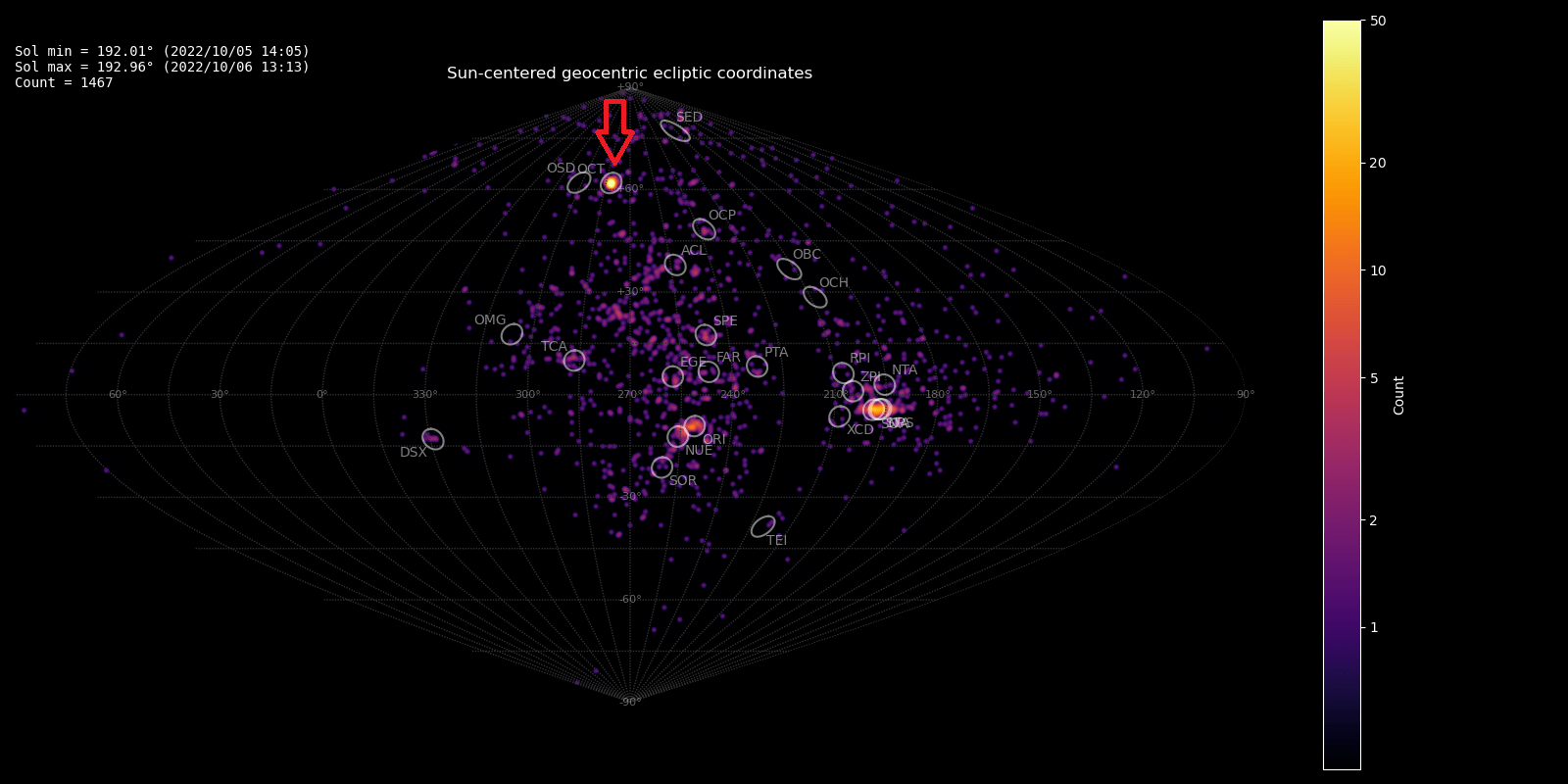
Figure 1 – The radiant map during the time interval 192.01° < λʘ < 192.96° (2022 October 5, 14h05m to October 6, 13h13m UT). The red arrow indicates the bright spot of the very compact OCT#281 radiant in Sun-centered geocentric ecliptic coordinates.
Figure 2 – October Camelopardalid recorded by BE000E (Assenede, Belgium) at 2022 October 6, 02h48m54s UT, trajectory solved with BE0001, BE0005 and BE000D.
Figure 3 – October Camelopardalid recorded by BE0007 (Genk, Belgium) at 2022 October 6, 00h51m26s UT, multi-station with CZ0002 and FR0006.
Figure 4 – October Camelopardalid recorded by BE0005 (Grapfontaine, Belgium) at 2022 October 6, 02h00m09s UT, multi-station with BE0008, UK0004, UK001P, UK002C, UK0034, UK0041, UK004C, UK005P, UK006B, UK006D, UK007B, UK007E, UK007H and UK007U.
Figure 5 – October Camelopardalid recorded by BE0008 (Genk, Belgium) at 2022 October 6, 02h00m09s UT, same meteor as in Figure 4, triangulation based on as many as 15 camera stations!
Figure 6 – October Camelopardalid recorded by FR000X (Hagnicourt, France) at 2022 October 6, 04h40m31s UT, triangulated with BE0001, BE0005, BE0009, BE000B, BE000C, BE000J, UK0004, UK003W and UK0007W.
Figure 7 – October Camelopardalid recorded by UK0004 (Eastbourne, United Kingdom) at 2022 October 6, 04h40m31s UT, triangulated with BE0001, BE0005, BE0009, BE000B, BE000C, BE000J, FR000X, UK003W and UK0007W.
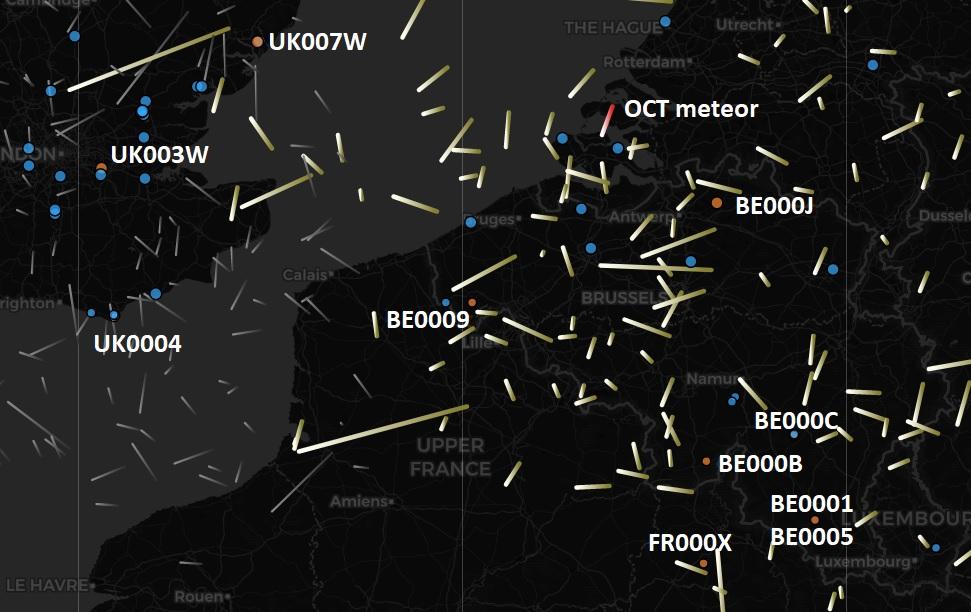
Figure 8 – Meteor map showing the trajectory for October 6, 04h40m31s UT and the stations that contributed to its triangulation.
The Global Meteor Network collected 1607 orbits during the night of 2022 October 5–6 (192.01° < λʘ < 192.96°). The October Camelopardalids did not display any spectacular events. A selection of imaged OCT meteors is shown in Figures 2 to 7. Interested readers can find the trajectories and contributing camera stations on the Meteor Map provided by Tammo-Jan Dijkema. Figure 8 shows a screenshot of the Meteor Map with the trajectory obtained for the meteor shown in Figures 6 and 7. All details about the Meteor Map and how to use this has been presented in an article (Dijkema, 2022).
The GMN data
The Global Meteor Network identified 254 orbits as October Camelopardalids since 2019. This identification has been made based on a list of known meteor showers (Jenniskens et al., 2018) for orbits recorded within 1° in solar longitude of the known activity period, with the radiant within 3° relative to the known radiant position and with a geocentric velocity vg within an interval of 10% relative to the reference geocentric velocity (Moorhead et al., 2020). Details about the methodology, theory and results of the Global Meteor Network can be found in Vida et al. (2019; 2020; 2021).
In 2022 alone, as many as 159 OCT#281 orbits were counted while the numbers in previous years were more modest with 57 in 2021, only 11 in 2020 and 27 orbits in 2019. Weather circumstances as well as the number of contributing GMN cameras may explain the variation from year to year. Short duration showers can be easily missed; therefore, cameras are needed at as many sites as possible.
The shower identification based on a reference list, radiant position and velocity, is not absolute, but has a good probability that the meteor may belong to the shower. This shower association still risks including sporadics. To eliminate these, we should look at the orbits to remove outliers that deviate too much from the mean orbit. This can be due to errors, mainly the velocity determination being very sensitive to measurement inaccuracies, or just ‘noise’ caused by look-alike sporadics. Whatever the cause may be, such outliers or noise should be removed to establish a reliable mean orbit.
When the 2018 analysis was made our knowledge about this shower was almost nonexistent. The samples to search for possible OCT-orbits were taken over a rather long range in solar longitude, a wide radiant area in equatorial coordinates and a large interval in velocity. Meanwhile we know that the activity of the shower is very short, therefore in this study we limited the period to search for OCT orbits to only 3 degrees in solar longitude. With a declination between 74° and 84°, the equatorial coordinates were not the best choice to define the radiant area to search for orbits. The Sun-centered coordinates offer a better alternative. To search for OCT orbits, we selected our sample within the following intervals:
- 191° < λʘ < 194°
- 273° < λ –λʘ < 290°
- +57° < β< +67°
- 39 km/s < vg< 51 km/s
The GMN data has 266 orbits that fulfill these conditions. This sample has been searched with an iterative procedure to locate the best fitting mean orbit for a concentration of similar orbits. The method used for this has been described before (Roggemans et al., 2019) and combines three classic discrimination criteria, considering different classes for the degree of similarity. The discrimination criteria used in this method are that of Southworth and Hawkins (1963), identified as DSH, Drummond (1981), identified as DD, and Jopek (1993), identified as DH. The method to compute the mean orbit during the iteration process has been described by Jopek et al. (2006).
We define five different classes with specific threshold levels of similarity:
- Low: DSH < 0.25 & DD < 0.105 & DH < 0.25;
- Medium low: DSH < 0.2 & DD < 0.08 & DH < 0.2;
- Medium high: DSH < 0.15 & DD < 0.06 & DH < 0.15;
- High: DSH < 0.1 & DD < 0.04 & DH < 0.1.
- Very high: DSH < 0.05 & DD < 0.02 & DH < 0.05.
These classes allow us to distinguish the degree of concentration and dispersion of the particles within the meteoroid stream. The iterative search identifies 239 orbits with low threshold similarity of which as many as 121 fit the very high threshold similarity. The mean orbits for each threshold class of similarity are listed in Table 1. The values are almost identical regardless the class of similarity.
Table 1 – The mean orbits for the final selection of Global Meteor Network orbits with five different threshold levels on the D-criteria.
| Low | Medium low | Medium high | High | Very high |
|
| λʘ | 192.53° | 192.53° | 192.53° | 192.53° | 192.53° |
| αg | 167.9° | 167.9° | 167.9° | 167.9° | 167.9° |
| δg | +78.6° | +78.6° | +78.6° | +78.6° | +78.6° |
| vg | 45.8 | 45.8 | 45.8 | 45.9 | 45.9 |
| λ – λʘ | 281.8° | 281.8° | 281.8° | 281.8° | 281.8° |
| β | +61.9° | +61.9° | +61.9° | +61.9° | +61.9° |
| Hb | 108.3 | 108.3 | 108.3 | 108.4 | 108.4 |
| He | 95.5 | 95.4 | 95.5 | 95.4 | 95.1 |
| a | 17.9 | 18.3 | 19.0 | 19.5 | 20.4 |
| q | 0.9901 | 0.9903 | 0.9905 | 0.9907 | 0.9907 |
| e | 0.9447 | 0.9460 | 0.9479 | 0.9492 | 0.9516 |
| ω | 169.17° | 169.24° | 169.19° | 169.05° | 168.94° |
| Ω | 192.54° | 192.54° | 192.54° | 192.53° | 192.53° |
| i | 77.77° | 77.72° | 77.81° | 77.86° | 77.91° |
| Π | 1.71° | 1.77° | 1.73° | 1.58° | 1.46° |
| Tj | 0.55 | 0.54 | 0.53 | 0.52 | 0.51 |
| N | 239 | 229 | 211 | 172 | 121 |
19 of the 254 orbits classified as OCT#281 by GMN fail to fit the low threshold similarity. In all these cases a too large or too small value for the eccentricity e makes the orbit fail to fit with the mean orbit derived by the iterative procedure. The eccentricity depends mainly on the velocity and the uncertainties on the velocities are rather small, in the order of ±0.01 to ±1.2 km/s at most, suggesting that these may be sporadics mistaken as OCT shower members at the initial shower classification. On the other hand, two orbits classified by the GMN as sporadics, and two orbits classified as October 6-Draconids (OSD#745) are considered as OCT#281 orbits as these fit the similarity criteria. Taking a preliminary defined radiant position and velocity range to make a first assessment of the shower association risks to include some sporadic events fitting these criteria by chance, while real shower members may be missed as the radiant size is not exactly known.
Most of the October Camelopardalid activity seems to be concentrated within about half a day of activity. Figure 10 shows the flux and corresponding zenithal hourly rate for all years together (2019–2022), assuming a population index r = 2.5 as there weren’t enough meteors from single stations to determine a population index. Figure 11 shows the profile based on 2022 only. The flux at low levels and outside the peak is probably completely caused by sporadics, as there is no sporadic contamination suppression applied to the flux plots. The methodology to compute the flux and derived ZHR values has been explained in Vida et al. (2022). With a maximum ZHR of about 5, the shower activity should catch the attention of any experienced visual observers. However, any uninformed casual observer will most likely not notice anything unusual at all.
All OCT-orbits that fit the similarity criteria were detected in the interval 191.25° < λʘ < 193.58° which includes all outliers. The main activity of this shower was limited to 192.3° < λʘ < 192.75°, or about 11 hours. This is in good agreement with Koseki (2021, page 166). The activity profile could be also reconstructed as a percentage of the number of OCT orbits relative to the number of sporadic orbits. In Figure 12 the different classes of similarity contributing to the shower activity show that the main activity consists of very similar orbits. Short duration meteor showers like this can be easily missed when the observing window suffers bad weather interference or a lack of camera coverage.
The velocity range with 41.78 km/s < vg < 48.77 km/s, is smaller than what we assumed to select the search sample. A range of 10% more or less than the mean geocentric velocity of 45.8 km/s definitely covers all possible orbits.
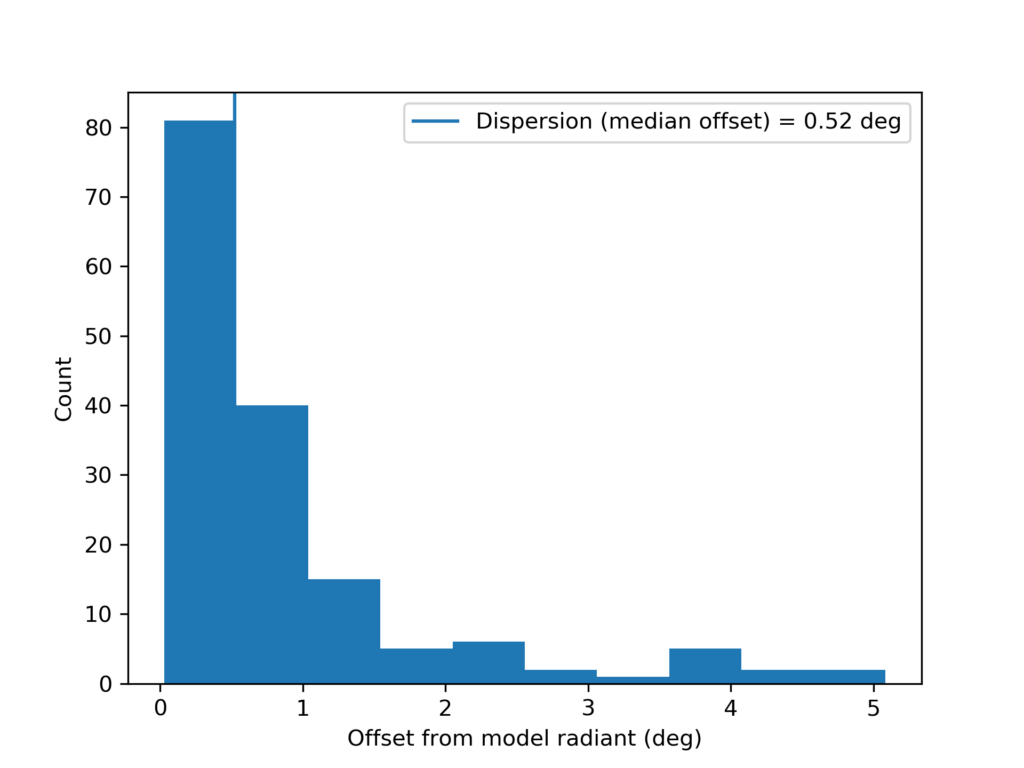
Figure 9 – The median offset from the mean radiant.
The median offset from the mean radiant as defined by Moorhead et al. (2021) is 0.52° (Figure 9). This makes the shower very compact and non-evolved, possibly young. The compactness of the shower appears also in the radiant plot with most orbits clustered within a radiant with few degrees in diameter. This is very well visible in the equatorial geocentric coordinates, although being at high declination (Figure 13). The compactness of the radiant is even more striking in Sun-centered ecliptic geocentric coordinates (Figure 14). Apart from some outliers with a low similarity threshold, most orbits share a very compact radiant area. Taking a close-up color coded for the geocentric velocity, we see that the outliers at higher ecliptic latitude are slower and those at lower ecliptic latitude faster compared to the concentration of orbits (Figure 15).
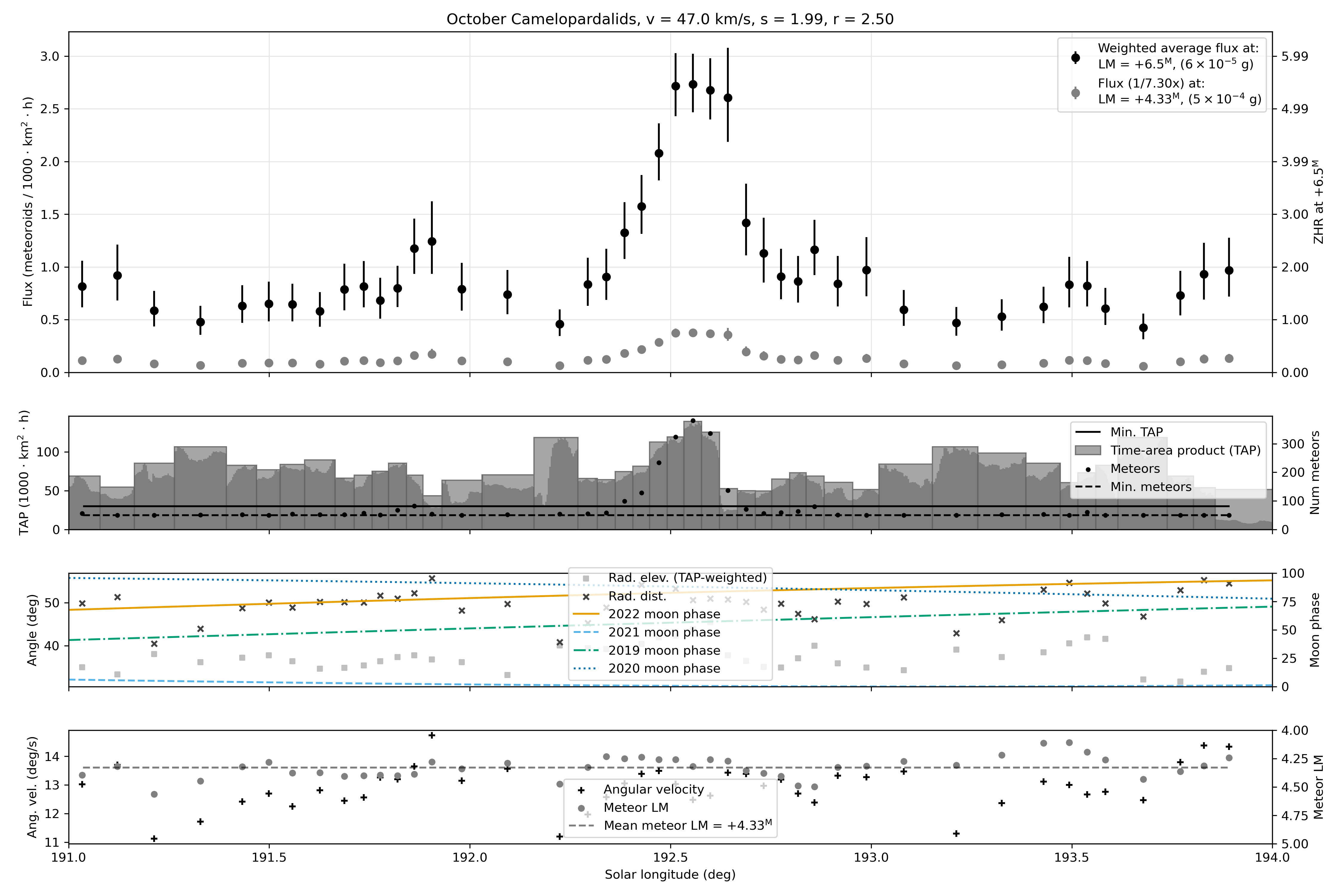 Figure 10 – The flux and corresponding ZHR profile for the October Camelopardalids (OCT#281) based on GMN data collected during the period 2019–2022.
Figure 10 – The flux and corresponding ZHR profile for the October Camelopardalids (OCT#281) based on GMN data collected during the period 2019–2022.
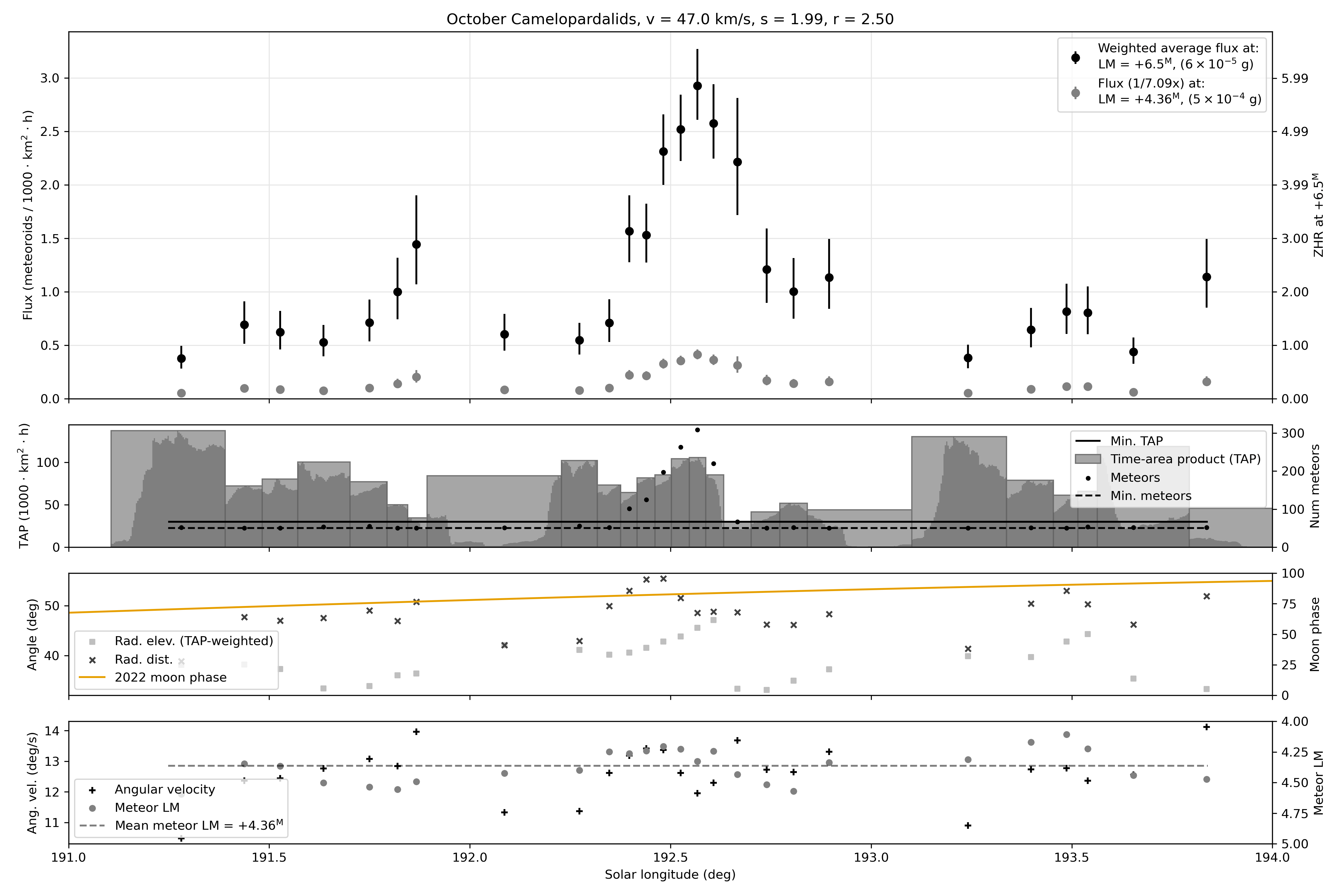
Figure 11 – The flux and corresponding ZHR profile for the October Camelopardalids (OCT#281) based on GMN data collected during 2022.
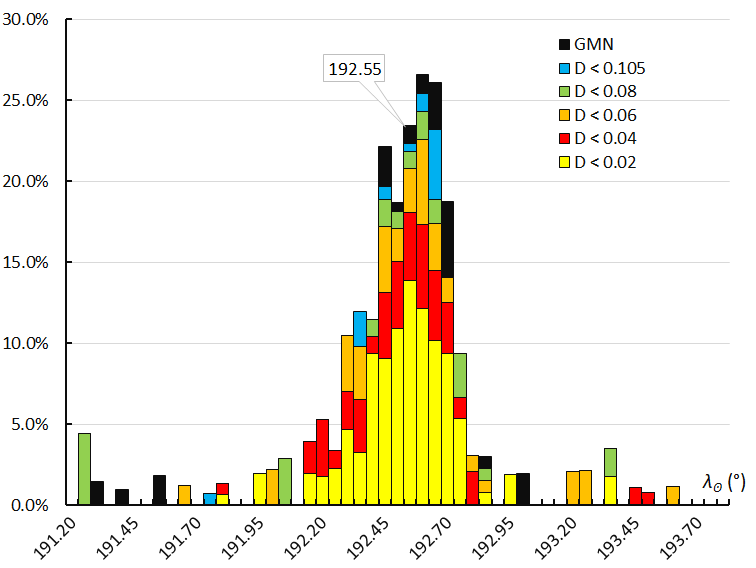
Figure 12 – Percentage of OCT#281 orbits relative to the number of sporadic orbits for the GMN shower identification and the different classes of similarity.
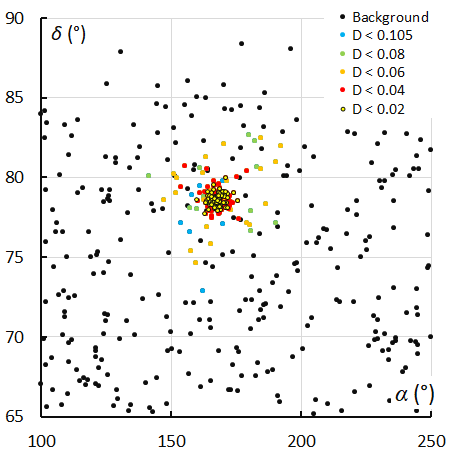
Figure 13 – The radiant plot for the OCT-orbits in equatorial geocentric coordinates, color coded according to the similarity classes.
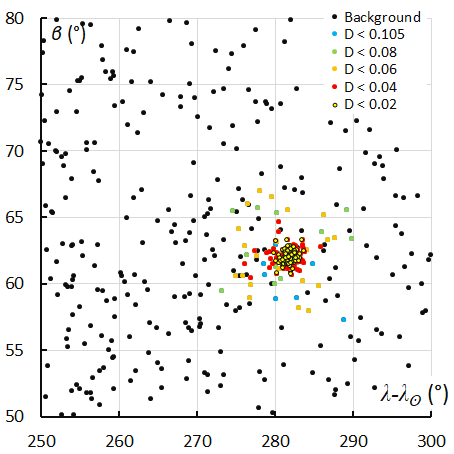
Figure 14 – The radiant plot for the OCT-orbits in Sun-centered ecliptic coordinates, color coded according to the similarity classes.
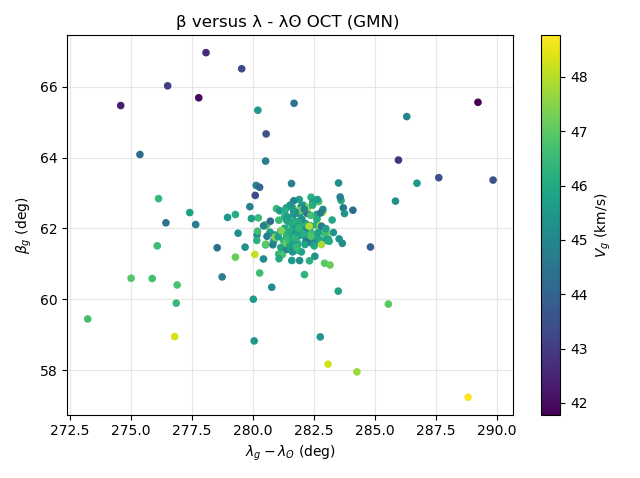
Figure 15 – The radiant plot for the OCT-orbits in Sun-centered ecliptic coordinates color coded for the geocentric velocity.
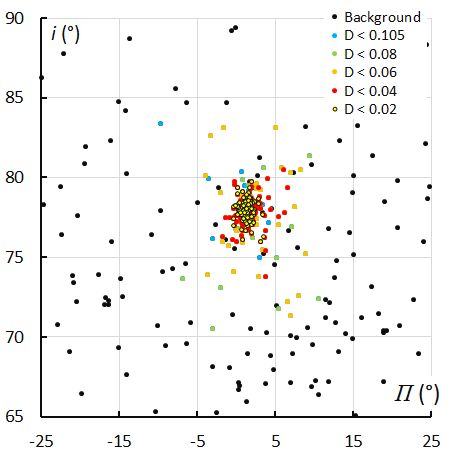
Figure 16 – The distribution of the inclination i against the longitude of perihelion Π for the OCT orbits, color coded according to the similarity classes.
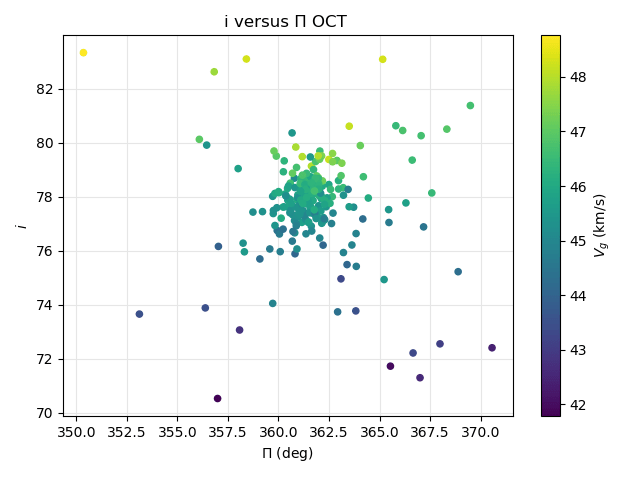
Figure 17 – The distribution of the inclination i against the longitude of perihelion Π for the OCT orbits, color coded for the geocentric velocity.
The distribution of inclination i against longitude of perihelion Π confirms the compactness of this meteoroid stream (Figure 16). A closer look at the velocity variation shows the faster OCT meteoroids at higher inclination and the slower meteoroids at lower inclination with a dense concentration near i = 77.8°. Also, the spread in longitude of perihelion is very narrow (Figure 17).
The distribution of the eccentricity e against the longitude of perihelion π shows several outliers with e > 1 (Figure 18). With a mean eccentricity of about 0.95 we are close to the parabolic limit, even a small error in the velocity measurement can result in a hyperbolic orbit. The close up in Figure 19 shows the spread in geocentric velocity, the higher the velocity, the higher the eccentricity value.
Figure 20 shows the distribution of the inclination i against the perihelion distance q. Apart from some outliers the bulk of the orbits are concentrated within a small range.
Figure 21 shows the corresponding velocity distribution with higher velocities at higher inclination.
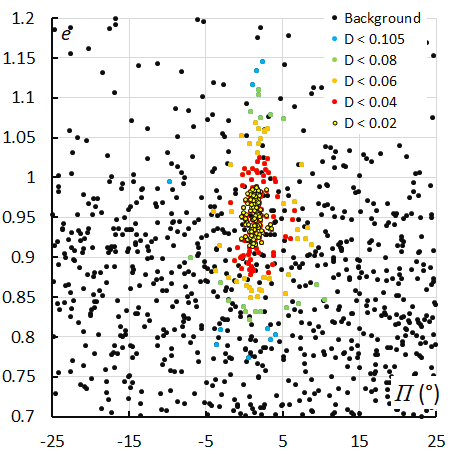
Figure 18 – The distribution of the eccentricity e against the longitude of perihelion Π for the OCT orbits, color coded according to the similarity classes.
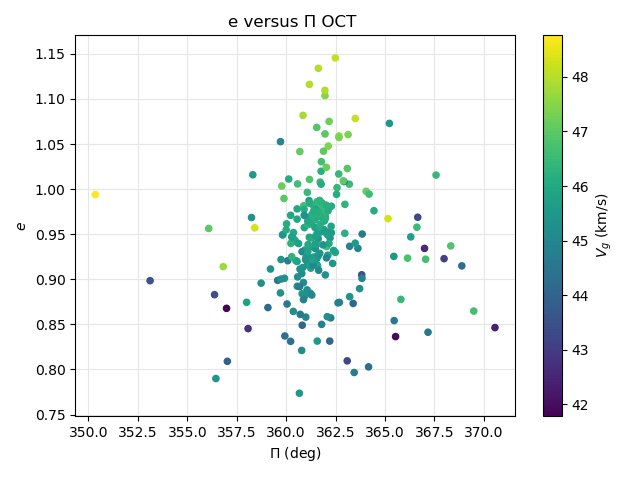
Figure 19 – The distribution of the eccentricity e against the longitude of perihelion Π for the OCT orbits, color coded for the geocentric velocity.
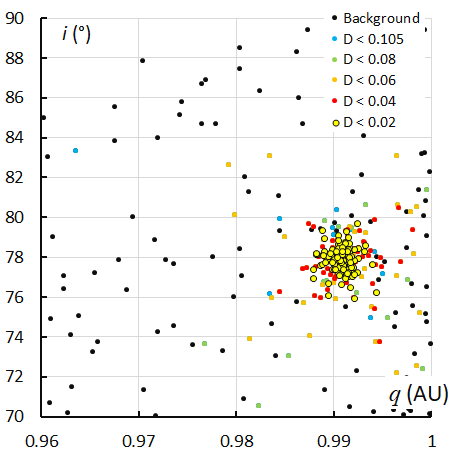
Figure 20 – The distribution of the inclination i against the perihelion distance q for the OCT orbits, color coded according to the similarity classes.
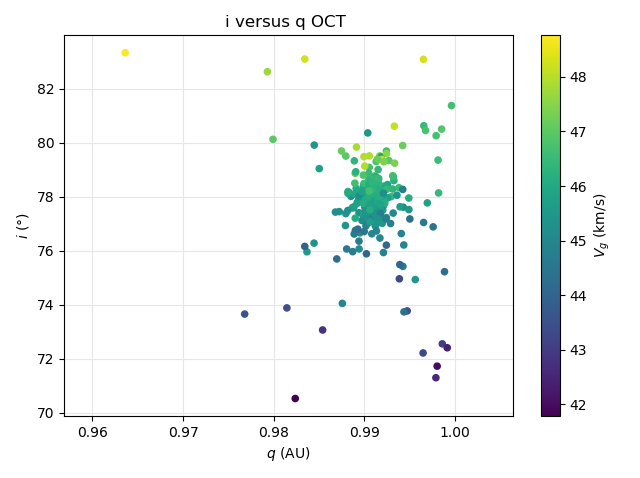
Figure 21 – The distribution of the inclination i against the perihelion distance q for the OCT orbits, color coded for the geocentric velocity.
The distribution of the eccentricity e against the inclination i (Figure 22), shows the same distorted pattern as in Figure 18 affected by hyperbolic orbits caused by the uncertainties on the velocity measurement. The velocity distribution in Figure 23 shows the spread from the left bottom corner with lower eccentricity and inclination towards the upper right corner with higher inclination and eccentricity. Most of the orbits are concentrated within a narrow range around the mean values.
The distribution of the eccentricity e against the perihelion distance q (Figure 24) also shows a compact concentration of orbits with outliers which were recorded with lower or higher velocities than the main concentration (Figure 25).
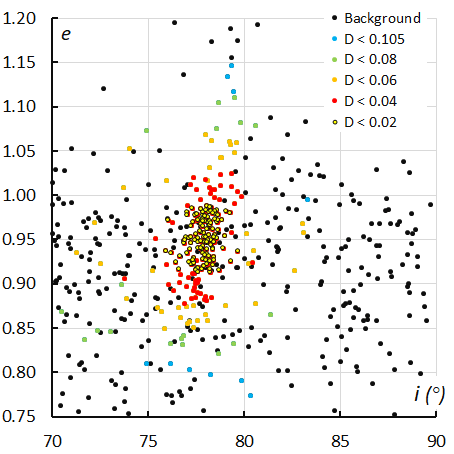
Figure 22 – The distribution of the eccentricity e against the inclination i for the OCT orbits, color coded according to the similarity classes.
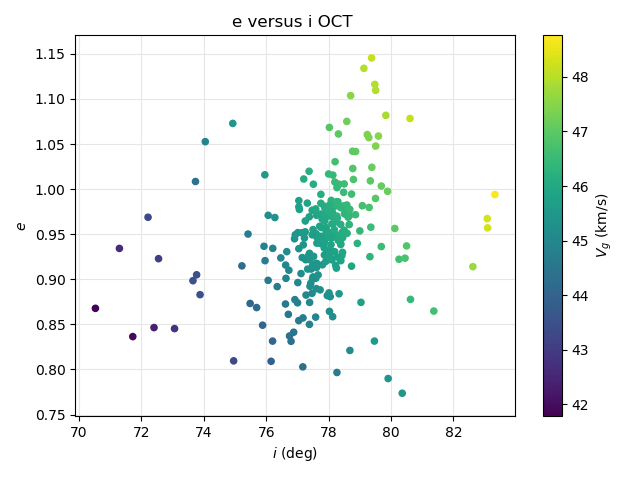
Figure 23 – The distribution of the eccentricity e against the inclination i for the OCT orbits, color coded for the geocentric velocity.
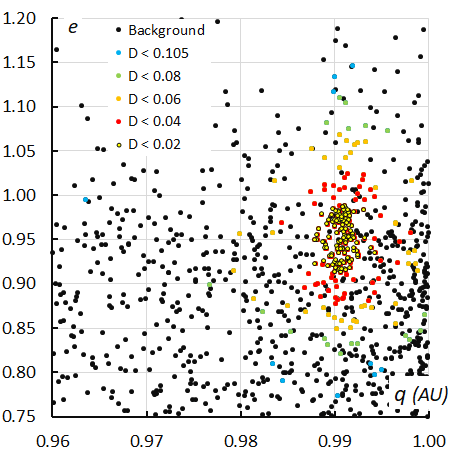
Figure 24 – The distribution of the eccentricity e against the perihelion distance q for the OCT orbits, color coded according to the similarity classes.
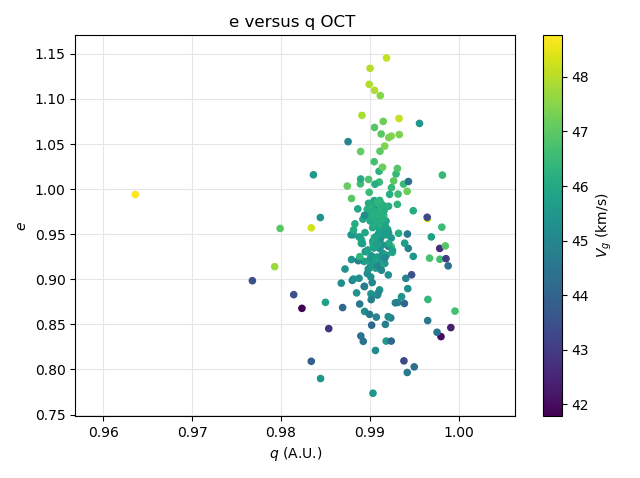
Figure 25 – The distribution of the eccentricity e against the perihelion distance q for the OCT orbits, color coded for the geocentric velocity.
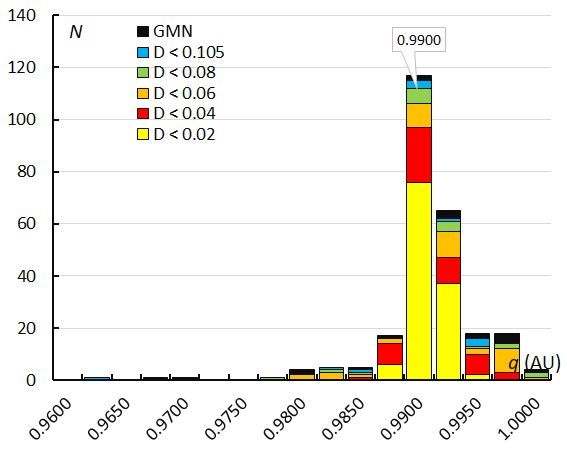
Figure 26 – The histogram for the distribution of the perihelion distance q.
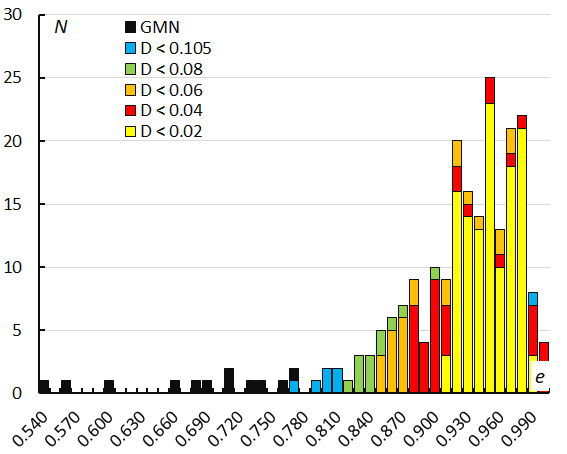
Figure 27 – The histogram for the distribution of the eccentricity e.
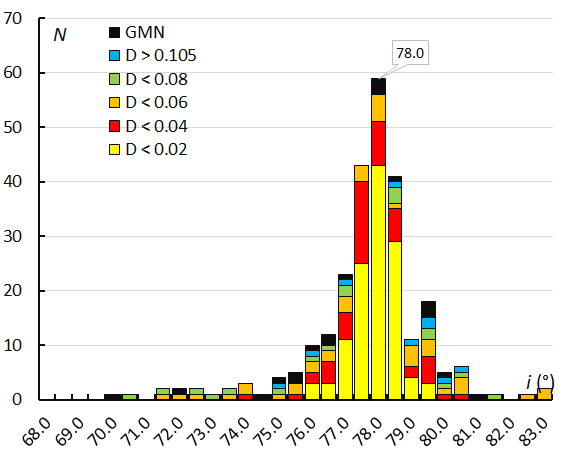
Figure 28 – The histogram for the distribution of the inclination i.
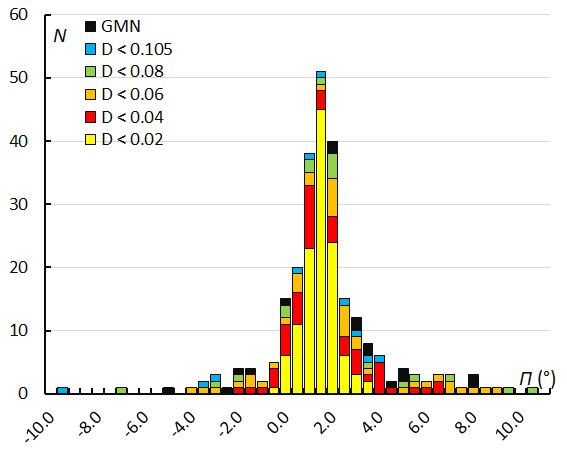
Figure 29 – The histogram for the distribution of the longitude of perihelion Π.
The spread in the main orbital elements q (Figure 26), e (Figure 27), i (Figure 28) and Π (Figure 29) also confirm the compactness of this meteoroid stream. Only the eccentricity appears more dispersed due to the effect of the velocity being close to the parabolic limit.
With a TJ value of about 0.5 and a long period orbit (P about 92 years) the OCT#281 appears to be of the type of prograde long-period comet showers. So far, no parent comet is known for this meteoroid stream. With a heliocentric velocity vh close to the parabolic limit of 42.1 km/s at the Earth orbit, even small errors on the velocity determination can result in hyperbolic orbits.
Comparing to other networks
We can compare the results obtained by the Global Meteor Network with some other public available datasets of meteoroid orbits. For this purpose, we can search the orbit datasets made available for EDMOND (Kornos et al., 2014), CAMS (Jenniskens et al., 2011) and SonotaCo (SonotaCo, 2009). The same selection criteria and iterative procedure has been applied to locate the mean orbit for these datasets as described above for the GMN orbit data. We also checked older photographic meteor orbit lists, but we couldn’t find any single orbit matching the October Camelopardalid orbit. For reason of cost effectiveness photographic meteor campaigns were limited in time, often covering mainly well-known shower activity. All year around all-sky coverage by fireball networks also produces orbit data, but this orbit data is a magnitude less in accuracy compared to the typical small field of view video optics. Radar orbits were not checked for the obvious reason that meteor orbits obtained by radar from the past tend to be rather inaccurate.
The CAMS network has 41 possible OCT orbits recorded between 2011 and 2016. Only 12 orbits fit the very high threshold similarity criteria, used for the final best fitting mean orbit for this dataset. SonotaCo has 56 possible OCT orbits recorded between 2007 and 2021 with 22 orbits fitting the very high threshold similarity criteria for its mean orbit. EDMOND has 69 possible OCT orbits collected between 2010 and 2016. 17 of these orbits could be used to compute a mean orbit based on the very high threshold similarity criteria. The results for the different datasets are in good agreement.
In Table 2 we compare the final mean orbit for the different datasets with the very high similarity threshold (DSH < 0.05 and DD < 0.02). SonotaCo has rather few matching orbits for the October Camelopardalids mainly because this period of the year often brings bad weather circumstances in Japan. The main difference with the results of the 2018 analysis (Roggemans et al., 2019) is that the selection criteria for this study are reduced to the time interval of 3 degrees in solar longitude against 25 degrees in the 2018 analysis. Most matching orbits beyond the short activity interval are isolated events that can be regarded as noise, or with other words sporadics that resemble the OCT orbit by pure chance.
Table 2 – The mean orbit obtained by the Global Meteor Network compared to the mean orbits obtained for independent datasets with meteoroid orbits obtained by CAMS, SonotaCo and EDMOND, all for the very high threshold similarity class
(DSH < 0.05 & DD < 0.02 & DH < 0.05).
| GMN | CAMS | SonotaCo | EDMOND | |
| λʘ (°) | 192.53° | 192.61° | 192.57° | 192.55° |
| αg (°) | 167.9° | 169.1° | 168.1° | 168.7° |
| δg (°) | +78.6° | +78.6° | +78.6° | +78.6° |
| vg (km/s) | 45.9 | 46.0 | 45.7 | 45.3 |
| λ – λʘ (°) | 281.8° | 282.2° | 281.9° | 281.9° |
| β (°) | +61.9° | +62.2° | +62.0° | +62.0 |
| Hb (km) | 108.4 | 109.1 | 107.9 | 107.2 |
| He (km) | 95.1 | 97.0 | 95.1 | 92.3 |
| a (AU) | 20.4 | 22.2 | 17.8 | 12.5 |
| q (AU) | 0.9907 | 0.9907 | 0.9906 | 0.9904 |
| e | 0.9516 | 0.9553 | 0.9445 | 0.9210 |
| ω (°) | 168.94° | 168.94° | 168.88° | 168.88° |
| Ω (°) | 192.53° | 192.56° | 192.57° | 192.55° |
| i (°) | 77.91° | 77.84° | 77.81° | 77.36° |
| Π (°) | 1.46° | 1.50° | 1.45° | 1.43° |
| Tj | 0.51 | 0.49 | 0.55 | 0.68 |
| N | 121 | 12 | 22 | 17 |
Conclusions
The October Camelopardalids (OCT#281) caught attention with 159 orbits identified by GMN in 2022. This long-period comet type shower displayed its main activity in the short interval 192.3° < λʘ < 192.75°. The time of maximum activity occurred at λʘ = 192.55° corresponding to 2022 October 06, 03h15m UT. The activity level at maximum with a ZHR of 5 should catch attention of experienced visual meteor observers watching under good circumstances.
The radiant has a small diameter of only few degrees. The median offset from the mean radiant is 0.52°. This makes the shower very compact and non-evolved, possibly young. The compact nature of this meteoroid stream appears also in different diagrams. Rather few dispersed outliers appear in the graphs with exception for the diagrams with the eccentricity e which is the most sensitive orbital parameter for the uncertainties on the measured velocity as the heliocentric velocity is close to the escape velocity from the Sun at the Earth orbit.
Showers with a short activity period of less than 1 degree in solar longitude are easily missed due to bad weather circumstances or poor camera coverage. So far there is no indication for a periodicity in strong October Camelopardalid activity. No parent body has been found for this meteoroid stream.
Acknowledgment
The authors thank all the camera operators and people involved in the Global Meteor Network. Orbits for this shower analysis were obtained by GMN RMS cameras. The Global Meteor Network (GMN) data are released under license.
The Global Meteor Network results were obtained thanks to the efforts of the following volunteers: Richard Abraham, Victor Acciari, Rob Agar, Yohsuke Akamatsu, David Akerman, Daknam Al-Ahmadi, Jamie Allen, Alexandre Alves, Don Anderson, Željko Andreić, Martyn Andrews, Enrique Arce, Georges Attard, Chris Baddiley, David Bailey, Roger Banks, Hamish Barker, Jean-Philippe Barrilliot, Ricky Bassom, Richard Bassom, Alan Beech, Dennis Behan, Ehud Behar, Josip Belas, Alex Bell, Florent Benoit, Serge Bergeron, Denis Bergeron, Jorge Bermúdez Augusto Acosta, Steve Berry, Adrian Bigland, Chris Blake, Arie Blumenzweig, Ventsislav Bodakov, Robin Boivin, Claude Boivin, Bruno Bonicontro, Fabricio Borges, Ubiratan Borges, Dorian Božičević, David Brash, Stuart Brett, Ed Breuer, Martin Breukers, John W. Briggs, Gareth Brown, Peter G. Brown, Laurent Brunetto, Tim Burgess, Jon Bursey, Yong-Ik Byun, Ludger Börgerding, Sylvain Cadieux, Peter Campbell-Burns, Andrew Campbell-Laing, Pablo Canedo, Seppe Canonaco, Jose Carballada, Steve Carter, David Castledine, Gilton Cavallini, Brian Chapman, Jason Charles, Matt Cheselka, Enrique Chávez Garcilazo, Tim Claydon, Trevor Clifton, Manel Colldecarrera, Michael Cook, Bill Cooke, Christopher Coomber, Brendan Cooney, Jamie Cooper, Andrew Cooper, Edward Cooper, Paul Cox, Llewellyn Cupido, Christopher Curtis, Chris Dakin, Fernando Dall’Igna, James Davenport, Richard Davis, Steve Dearden, Christophe Demeautis, Bart Dessoy, Pat Devine, Miguel Diaz Angel, Paul Dickinson, Ivo Dijan, Pieter Dijkema, Tammo Dijkema Jan, Luciano Diniz Miguel, Marcelo Domingues, Stacey Downton, Stewart Doyle, Zoran Dragić, Iain Drea, Igor Duchaj, Jean-Paul Dumoulin, Garry Dymond, Jürgen Dörr, Robin Earl, Howard Edin, Ollie Eisman, Carl Elkins, Ian Enting Graham, Peter Eschman, Nigel Evans, Bob Evans, Bev M. Ewen-Smith, Seraphin Feller, Eduardo Fernandez Del Peloso, Andres Fernandez, Andrew Fiamingo, Barry Findley, Rick Fischer, Richard Fleet, Jim Fordice, Kyle Francis, Jean Francois Larouche, Patrick Franks, Stefan Frei, Gustav Frisholm, Jose Galindo Lopez, Pierre Gamache, Mark Gatehouse, Ivan Gašparić, Chris George, Megan Gialluca, Kevin Gibbs-Wragge, Marc Gilart Corretgé, Jason Gill, Philip Gladstone, Uwe Glässner, Chuck Goldsmith, Hugo González, Nikola Gotovac, Neil Graham, Pete Graham, Colin Graham, Sam Green, Bob Greschke, Daniel J. Grinkevich, Larry Groom, Dominique Guiot, Tioga Gulon, Margareta Gumilar, Peter Gural, Nikolay Gusev, Kees Habraken, Alex Haislip, John Hale, Peter Hallett, Graeme Hanigan, Erwin Harkink, Ed Harman, Marián Harnádek, Ryan Harper, David Hatton, Tim Havens, Mark Haworth, Paul Haworth, Richard Hayler, Andrew Heath, Sam Hemmelgarn, Rick Hewett, Nicholas Hill, Lee Hill, Don Hladiuk, Alex Hodge, Simon Holbeche, Jeff Holmes, Steve Homer, Matthew Howarth, Nick Howarth, Jeff Huddle, Bob Hufnagel, Roslina Hussain, Jan Hykel, Russell Jackson, Jean-Marie Jacquart, Jost Jahn, Nick James, Phil James, Ron James Jr, Rick James, Ilya Jankowsky, Alex Jeffery, Klaas Jobse, Richard Johnston, Dave Jones, Fernando Jordan, Romulo Jose, Edison José Felipe Pérezgómez Álvarez, Vladimir Jovanović, Alfredo Júnior Dal’Ava, Javor Kac, Richard Kacerek, Milan Kalina, Jonathon Kambulow, Steve Kaufman, Paul Kavanagh, Ioannis Kedros, Jürgen Ketterer, Alex Kichev, Harri Kiiskinen, Jean-Baptiste Kikwaya, Sebastian Klier, Dan Klinglesmith, John Kmetz, Zoran Knez, Korado Korlević, Stanislav Korotkiy, Danko Kočiš, Bela Kralj Szomi, Josip Krpan, Zbigniew Krzeminski, Patrik Kukić, Reinhard Kühn, Remi Lacasse, Gaétan Laflamme, Steve Lamb, Hervé Lamy, Jean Larouche Francois, Ian Lauwerys, Peter Lee, Hartmut Leiting, David Leurquin, Gareth Lloyd, Robert Longbottom, Eric Lopez, Paul Ludick, Muhammad Luqmanul Hakim Muharam, Pete Lynch, Frank Lyter, Guy Létourneau, Angélica López Olmos, Anton Macan, Jonathan Mackey, John Maclean, Igor Macuka, Nawaz Mahomed, Simon Maidment, Mirjana Malarić, Nedeljko Mandić, Alain Marin, Bob Marshall, Colin Marshall, Gavin Martin, José Martin Luis, Andrei Marukhno, José María García, Keith Maslin, Nicola Masseroni, Bob Massey, Jacques Masson, Damir Matković, Filip Matković, Dougal Matthews, Phillip Maximilian Grammerstorf Wilhelm, Michael Mazur, Sergio Mazzi, Stuart McAndrew, Lorna McCalman, Alex McConahay, Charlie McCormack, Mason McCormack, Robert McCoy, Vincent McDermott, Tommy McEwan, Mark McIntyre, Peter McKellar, Peter Meadows, Edgar Mendes Merizio, Aleksandar Merlak, Filip Mezak, Pierre-Michael Micaletti, Greg Michael, Matej Mihelčić, Simon Minnican, Wullie Mitchell, Georgi Momchilov, Dean Moore, Nelson Moreira, Kevin Morgan, Roger Morin, Nick Moskovitz, Daniela Mourão Cardozo, Dave Mowbray, Andrew Moyle, Gene Mroz, Brian Murphy, Carl Mustoe, Juan Muñoz Luis, Przemek Nagański, Jean-Louis Naudin, Damjan Nemarnik, Attila Nemes, Dave Newbury, Colin Nichols, Nick Norman, Philip Norton, Zoran Novak, Gareth Oakey, Perth Observatory Volunteer Group, Washington Oliveira, Jorge Oliveira, Jamie Olver, Christine Ord, Nigel Owen, Michael O’Connell, Dylan O’Donnell, Thiago Paes, Carl Panter, Neil Papworth, Filip Parag, Ian Parker, Gary Parker, Simon Parsons, Ian Pass, Igor Pavletić, Lovro Pavletić, Richard Payne, Pierre-Yves Pechart, Holger Pedersen, William Perkin, Enrico Pettarin, Alan Pevec, Mark Phillips, Anthony Pitt, Patrick Poitevin, Tim Polfliet, Renato Poltronieri, Derek Poulton, Janusz Powazki, Aled Powell, Alex Pratt, Miguel Preciado, Nick Primavesi, Paul Prouse, Paul Pugh, Chuck Pullen, Terry Pundiak, Lev Pustil’Nik, Dan Pye, Nick Quinn, Chris Ramsay, David Rankin, Steve Rau, Dustin Rego, Chris Reichelt, Danijel Reponj, Fernando Requena, Maciej Reszelsk, Ewan Richardson, Martin Richmond-Hardy, Mark Robbins, Martin Robinson, David Robinson, Heriton Rocha, Herve Roche, Paul Roggemans, Adriana Roggemans, Alex Roig, David Rollinson, Andre Rousseau, Jim Rowe, Nicholas Ruffier, Nick Russel, Dmitrii Rychkov, Robert Saint-Jean, Michel Saint-Laurent, Clive Sanders, Jason Sanders, Ivan Sardelić, Rob Saunders, John Savage, Lawrence Saville, Vasilii Savtchenko, Philippe Schaack, William Schauff, Ansgar Schmidt, Yfore Scott, James Scott, Geoff Scott, Jim Seargeant, Jay Shaffer, Steven Shanks, Mike Shaw, Jamie Shepherd, Angel Sierra, Ivo Silvestri, François Simard, Noah Simmonds, Ivica Skokić, Dave Smith, Ian A. Smith, Tracey Snelus, Germano Soru, Warley Souza, Mark Spink, Denis St-Gelais, James Stanley, Radim Stano, Laurie Stanton, Robert D. Steele, Yuri Stepanychev, Graham Stevens, Richard Stevenson, Thomas Stevenson, Peter Stewart, William Stewart, Paul Stewart, Con Stoitsis, Andrea Storani, Andy Stott, David Strawford, Claude Surprenant, Rajko Sušanj, Jeremy Taylor, Yakov Tchenak, John Thurmond, Stanislav Tkachenko, Eric Toops, Torcuill Torrance, Steve Trone, Wenceslao Trujillo, John Tuckett, Sofia Ulrich, Jonathan Valdez Aguilar Alexis, Edson Valencia Morales, Myron Valenta, Jean Vallieres, Paraksh Vankawala, Neville Vann, Marco Verstraaten, Arie Verveer, Jochen Vollsted, Predrag Vukovic, Aden Walker, Martin Walker, Bill Wallace, John Waller, Jacques Walliang, Didier Walliang, Christian Wanlin, Tom Warner, Neil Waters, Steve Welch, Tobias Westphal, Tosh White, Alexander Wiedekind-Klein, John Wildridge, Ian Williams, Mark Williams, Guy Williamson, Graham Winstanley, Urs Wirthmueller, Bill Witte, Jeff Wood, Martin Woodward, Jonathan Wyatt, Anton Yanishevskiy, Penko Yordanov, Stephane Zanoni, Pető Zsolt, Dario Zubović, Marcelo Zurita, Rob de Corday Long, Pierre de Ponthière, Jocimar Justino de Souza, Erwin van Ballegoij, Raoul van Eijndhoven, Ivica Ćiković, Dino Čaljkušić, Damir Šegon, Marko Šegon (list established 19 December 2022).
References
Dijkema T. J. (2022). “Visualizing meteor ground tracks on the meteor map”. eMetN, 7, 73–75.
Drummond J. D. (1981). “A test of comet and meteor shower associations”. Icarus, 45, 545–553.
Jenniskens P., Gural P. S., Grigsby B., Dynneson L., Koop M. and Holman D. (2011). “CAMS: Cameras for Allsky Meteor Surveillance to validate minor meteor showers”. Icarus, 216, 40–61.
Jenniskens P. (2006). Meteor Showers and their Parent Comets. ISBN 0521853494. Cambridge, UK: Cambridge University Press. Pages 528–530.
Jenniskens P., Baggaley J., Crumpton I., Aldous P., Pokorny P., Janches D., Gural P. S., Samuels D., Albers J., Howell A., Johannink C., Breukers M., Odeh M., Moskovitz N., Collison J. and Ganjuag S. (2018). “A survey of southern hemisphere meteor showers”. Planetary Space Science, 154, 21–29.
Jopek T. J. (1993). “Remarks on the meteor orbital similarity D-criterion”. Icarus, 106, 603–607.
Jopek T. J., Rudawska R. and Pretka-Ziomek H. (2006). “Calculation of the mean orbit of a meteoroid stream”. Monthly Notices of the Royal Astronomical Society, 371, 1367–1372.
Kornoš L., Matlovič P., Rudawska R., Tóth J., Hajduková M. Jr., Koukal J. and Piffl R. (2014). “Confirmation and characterization of IAU temporary meteor showers in EDMOND database”. In Jopek T. J., Rietmeijer F. J. M., Watanabe J., Williams I. P., editors, Proceedings of the Meteoroids 2013 Conference, Poznań, Poland, Aug. 26-30, 2013. A.M. University, pages 225–233.
Koseki M. (2021). “The activity of meteor showers recorded by SonotaCo Net video observations 2007–2018”. eMetN, 6, 91–246.
Moorhead A., Clements T.D. and Vida D. (2020). “Realistic gravitational focusing of meteoroid streams”. Monthly Notices of the Royal Astronomical Society, 494, 2982–2994.
Moorhead A. V., Clements T. and Vida D. (2021). “Meteor shower radiant dispersions in Global Meteor Network data”. Monthly Notices of the Royal Astronomical Society, 508, 326–339.
Roggemans P., Johannink C. and Cambell-Burns P. (2019). “October Ursae Majorids (OCU#333)”. eMetN, 4, 55–64.
Roggemans P., Johannink C. and Cambell-Burns P. (2019). “October Camelopardalids (OCT#281)”. eMetN, 4, 65–73.
SonotaCo (2009). “A meteor shower catalog based on video observations in 2007–2008”. WGN, Journal of the IMO, 37, 55–62.
Southworth R. B. and Hawkins G. S. (1963). “Statistics of meteor streams”. Smithsonian Contributions to Astrophysics, 7, 261–285.
Vida D., Gural P., Brown P., Campbell-Brown M., Wiegert P. (2019). “Estimating trajectories of meteors: an observational Monte Carlo approach – I. Theory”. Monthly Notices of the Royal Astronomical Society, 491, 2688–2705.
Vida D., Gural P., Brown P., Campbell-Brown M., Wiegert P. (2020). “Estimating trajectories of meteors: an observational Monte Carlo approach – II. Results”. Monthly Notices of the Royal Astronomical Society, 491, 3996–4011.
Vida D., Šegon D., Gural P. S., Brown P. G., McIntyre M. J., Eschman P., Roggemans P., Merlak A., Zubrović D. (2021). “The Global Meteor Network – Methodology and first results”. Monthly Notices of the Royal Astronomical Society, 506, 5046–5074.
Vida D., Blaauw Erskine R. C., Brown P. G., Kambulow J., Campbell-Brown M., Mazur M. J. (2022). “Computing optical meteor flux using global meteor network data”. Monthly Notices of the Royal Astronomical Society, 515, 2322–2339.

